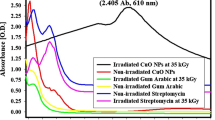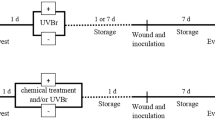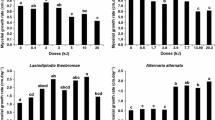Abstract
Rhizopus soft rot, caused by Rhizopus stolonifer, is a serious postharvest disease of sweet potatoes. Generally, the pathogen infects through wounds during storage and shipment after harvesting. To prevent losses, sweet potato packing houses have been using the fungicide dicloran, but many retail markets no longer allow dicloran residues. Recently, gamma-irradiation as a phytosanitary treatment was used to control plant pests and pathogens. In this study, we evaluated the combined effect of gamma irradiation and sodium dichloroisocyanurate (NaDCC) for control of Rhizopus soft rot. For an investigation of the effect of gamma irradiation and NaDCC treatment on conidia viability, we employed a dilution plate method. The results showed that gamma irradiation and NaDCC completely inhibited the growth of R. stolonifer at a 2.8 kGy dose and 20 ppm, respectively. The growth inhibition rate of R. stolonifer compared to the untreated control was 37.2% for the irradiation dose of 0.8 kGy, 61.5% for NaDCC at 10 ppm, and 73.6% for the combined treatment of 0.8 kGy irradiation dose and 10 ppm NaDCC. Based on the colour and weight loss measurement of the sweet potato slices, gamma irradiation treatment did not affect the physical quality. In an in vivo assay, the combination treatment of 0.6 kGy gamma irradiation and 10ppm NaDCC inhibited the fungal development. These results suggest that NaDCC treatment in combination with gamma irradiation is able to control Rhizopus soft rot disease of sweet potato or other fruits after harvesting.
Similar content being viewed by others
References
Ajlouni S & Hamdy MK, 1988. Effect of combined gammairradiation and storage on biochemical changes in sweet potato. J Food Sci 53, 477–481.
Akamatsu T, Tabata K, Hironaga M & Uyeda M, 1995. Antimicrobial activity and chemical stability of sodium dichloroisocyanurate. Jpn J Toxicol Environ Health 41, 134–141.
Aquino S, Ferreira F, Ribeiro DHB, Correa B, Greiner R & Villavicencio ALCH, 2005. Evaluation of viability of Aspergillus flavus and aflatoxins degradation in irradiated samples of maize. Braz J Microbiol 36, 352–356.
Aquino S, 2011. Gamma radiation against toxigenic fungi in food, medicinal and aromatic herbs. Science against microbial pathogens: communicating current research and technological advances A. Mendez-Vilas (Ed.).
Aziz NH, Farag S & Hassanin MA, 1991. Effect of gamma irradiation and water activity on mycotoxin production of Alternaria in tomato paste and juice. Die Nahrung 35, 359–362.
Aziz NH, El-Far FM, Shahin AAM & Roushy SM, 2007. Control of Fusarium moulds and fumonisin B1 in seeds by gamma-irradiation. Food Control 18, 1337–1342.
Bloomfield SF & Miles GA, 1978. The antibacterial properties of sodium dichloroisocyanurate and sodium hypochlorite formulations. J Appl Bacteriol 46, 65–73.
Choi EH, Park NP, Lee SR & Kim HS, 1968. Studies on the storage and utilization of sweetpotatoes (III) Gamma-irradiation and storage of sweetpotatoes. J Korean Soc Agric Chem Biochem 10, 63–68.
Cia P, Pascholati SF, Benato EA, Camili EC & Santos CA, 2007. Effects of gamma and UV-C irradiation on the postharvest control of papaya anthracnose. Postharvest Biol Technol 43, 366–373.
Clark CA, Holmes GJ & Ferrin DM, 2009. Major fungal and bacterial diseases. In: Loebenstein G, Thottappily G, eds. The sweetpotato, Heidelberg, Germany. Pp. 81–103.
Clark CA & Hoy MW, 1994. Identification of resistance in sweetpotato to Rhizopus soft rot using two inoculation methods. Plant Dis 78, 1078–1082.
Coates D, 1985. A comparision of sodium hypochlorite and sodium dichloroisocyanurate products. J Hosp Infec 6, 31–40.
Edmunds BA & Holmes GJ, 2009. Evaluation of alternative decay control products for control of postharvest Rhizopus soft rot of sweetpotatos. Online. Plant Health Progress doi: 10.1094/PHP-2009-0206-01-RS.
Ferreira-Castro FL, Aquino S, Greiner R, Ribeiro DHB, Reis TA & Correa B, 2007. Effects of gamma radiation on maize samples contaminated with Fusarium verticillioides. Appl Radiat Isotope 65, 927–933.
Fu AH, Sebranek JG & Murano EA, 1995. Survival of Listeria monocytogenes and Salmonella typhimurium and quality attributes of cooked pork chops and cured ham after irradiation. J Food Sci 60, 1001–1005.
Geweely NSI & Nawar LS, 2006. Sensitivity to gamma irradiation of post-harvest pathogens of pear. Int J Agri Biol 8, 710–716.
Kurian J, Bolla N & Damaraju B, 2012. Comparative evaluation of effectiveness of sodium dichloroisocyanurate and calcium hydroxide against Candida albicans. J Contemp Dent Pract 13, 665–670.
Hayashi T, 1985. Accumulation of sucrose in irradiated agricultural products. Jpn Agr Res Quarterly 19, 295–301.
Hussain PR, Dar MA & Wan AM, 2013. Impact of radiation processing on quality during storage and post-refrigeration decay of plum (Prunus domestica L.) cv. Santaroza. Radiat Phys Chem 85, 234–242.
Ley FI, 1983. Food irradiation, in Food Microbiology: Advances and Prospects. The Society of Applied Bacteriology Symposium Series No. 11 (Roberts, T.A. and Skinner, E.A., Eds.). Academic Press, London.
Lim BS, Yun HK, Hwang YS, Choi ST & Chung DS, 2003. Sterilizatioin of cold storage room using sodium dichloroisocyanurate. Kor J Hort Sci Technol 21, 209–211.
Maity JP, Chakraborty A, Saha A, Santra SC & Chanda S, 2004. Radiation-induced effects on some common storage edible seeds in India infested with surface microflora. Radiat Phys Chem 71, 1065–1072.
Mostafavi HA, Mirmajlessi SM, Mirjalili SM, Fathollahi H & Askari H, 2012. Gamma radiation effects on physico-chemical parameters of apple fruit during commercial post-harvest preservation. Radiat Phys Chem 8, 666–671.
Rustom IYS, 1997. Aflatoxin in food and feed: occurrence, legislation and inactivation by physical methods. Food Chem 59 (Suppl. 1), 57–67.
Slade SJ, Harris RF, Smith CS, Andrew JH & Nordheim, EV, 1987. Microplate assay for Colletotrichum spore production. Appl Environ Microbiol 53, 627–632.
Smith JC & Pillai S, 2004. Irradiation and food safety. Food Technology 58, 48–54.
Temur C & Tiryaki O, 2013. Irradiation alone or combined with other alternative treatments to control postharvest diseases. Afr J Agr Res 8, 421–434.
Tiryaki O & Maden S, 1991. Penicillium expansum, Botrytis cinerea ve Rhizopus nigricans ile Enfekteli Ankara Armutlar1nda Gamma Radyasyonunu ile Standart Depolama Koşullar1nda Çűrűmenin Engellenmesi. VI. Tűrkiye Fitopatoloji Kongresi. 7–11 Ekim, İzmir.
Tiryaki O, Aydin G & Gűrer M, 1994. Post harvest disease control of apple, quince, onion and peach, with radiation treatment. J Turk Phytopath 23, 143–152.
Wall MM, 2004. Compositional and sensory analyses of Hawaii-grown sweetpotatoes after x-ray irradiation quarantine treatment. Hort Science 39, 574–577.
Wall MM, 2005. Storage quality and composition of sweetpotato roots after quarantine treatment using low doses of X-ray irradiation. Hort Science 40, 424–427.
White TM, Bruns T, Lee S & Taylor J, 1990. Amplification and direct sequencing of fungal ribosomal RNA for phylogenetics. In: Innis MA, Gelfand DH, Sninsky JJ, White TJ, editors. PCR protocols: a guide to methods and applications. New York: Academic Press, 315–322.
Yoon MC, Jung K, Lee KY, Jeong J.Y, Lee & JW & Park HJ, 2014. Synergisitc effect of the combined treatment with gamma irradiation and sodium dichloroisocyanurate to control gray mold (Botrytis cinerea) on paprika. Radiat Phys Chem 98, 103–108.
Author information
Authors and Affiliations
Corresponding author
Rights and permissions
About this article
Cite this article
Jeong, JY., Yoon, MC., Lee, KY. et al. Effect of the combined treatment with gamma irradiation and sodium dichloroisocyanurate on postharvest Rhizopus soft rot of sweet potato. J Plant Dis Prot 121, 243–249 (2014). https://doi.org/10.1007/BF03356519
Received:
Accepted:
Published:
Issue Date:
DOI: https://doi.org/10.1007/BF03356519




